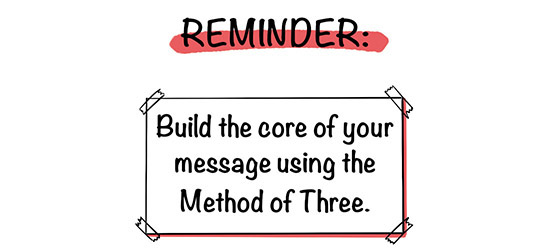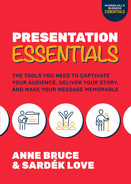
From Overcoming Hesitation to Giving a Great Presentation
Great presenters are made, not born. Throughout this book, we’re going to walk you through the “Essentials” of presentations, step-by-step and chapter by chapter. We’ll give you the foundation you’ll need to deliver a great presentation, from crafting a compelling opener to creating an audience-friendly, informative approach to ending with a powerful closing—and everything in between.
We begin with the truth that at some point in your business or personal life, you’ll be asked to present some kind of information to an audience. It might be giving a persuasive speech at your child’s PTA meeting or informing your work team about the latest government guidelines to follow. It requires courage to get in front of other people and share your message, which is why many people feel anxious when speaking or presenting in public. But they don’t have to. With solid preparation, skill development, a generous helping of self-confidence, and some style, you can become a successful presenter—maybe even a pro.
When you nurture a set of skills—ones that you may already possess—and work on confidence-building techniques, you’ll feel more prepared and less anxious about speaking in front of others. Once you’ve “trained your butterflies” (more on this later in this chapter), you can find your own unique way of connecting with your audience. And by “chunking down” your messages into influential bits, you’ll not only be better equipped to remember your main points as you present, but you’ll present in a way that allows your audience to easily remember your content.
Whether you’re an introvert or extrovert, have delivered zero presentations or 100, or hate the idea of being in front of an audience, you can always improve and thrive. In fact, when we began our careers as professional presenters, we didn’t have all the skills we needed. Instead, we developed and polished them over time, and you can, too!
DEVELOP ESSENTIAL PRESENTATION SKILLS
Presentation skills are the building blocks you’ll use to construct and deliver your presentation.
Topping the list of valuable presentation skills are authenticity and humility because both establish your credibility with your audience. Always remember to be yourself and be natural. Almost anything else will come across as phony, false, and insincere. (Unless, of course, you’re auditioning for a part in a movie, in which case go for it. Actors are presenters, too!) Developing your appeal and persona in an authentic way (via humor, a personal clothing style, or props, for instance) is a skill that will help you remain memorable and marketable. By using your signature presentation style, discussed in-depth in Chapter 11, you’ll connect with an audience and influence how successfully your message is communicated.
Armed with other important skills, such as good verbal communication, annunciation (projecting your voice), and articulation (speaking clearly), you’ll deliver a memorable message with confidence and clarity. Try not to mumble—instead, be proud that you have a valuable contribution to share. Strong nonverbal communication skills, such as body language, facial expressions, and how you move (or don’t move), all influence how relatable you appear to your audience.
A little self-confidence will help if you are nervous about speaking in front of others. Believe in yourself and be confident that you have been tasked with presenting because you know your content. Your confidence will show in your body language and stance. Remember, your audience wants you to succeed, too.
Using a distinct voice can be appealing to your audience as well. Some of the most memorable presenters, like the late Gilbert Gottfried or comedian Bobcat Goldthwait, have unusual and distinct voices that separate them from the pack. If your voice is an asset you’d like to develop, work with coaches who specialize in speech and voice.
Self-awareness and emotional intelligence aren’t necessarily skills, but they are useful and important tools a presenter should develop. If you’re presenting in front of an audience, keep calm and cool, especially when confronted with a difficult audience, a technology failure, a stage malfunction, or any number of unexpected issues that may appear during a presentation. The goal of presenting is being able to communicate your message in a clear and compelling way, regardless of any obstacles you may encounter.
Armed with these skills, a dash of quick thinking, and a sprinkle of showmanship, you’ll be presenting like a pro in no time.

HOW TO TRAIN YOUR BUTTERFLIES
Earlier we mentioned “training your butterflies.” Before getting to the how-to, it’s important to know that everyone gets that fluttering deep in the gut or that nervousness when anxious—and some feel that especially when giving a presentation. There’s even a word for fear of public speaking: glossophobia. While this may be true, any excessive nervousness you feel or show can be distracting to your audience. Signs of nervousness include fidgeting with your hands, spinning a pen, touching yourself too much, constantly running your fingers through your hair, always clearing your throat, excessive blinking, swallowing a lot, tapping a pencil, saying “um” or “uh” after every sentence (that’s the most distracting), and your hands shaking.
To understand where you are on your presentation journey right now, take time to list those signs that make you appear nervous.
Once you’ve identified what makes you look nervous, use that awareness to address and eliminate these habits. Here are a few nerve-controlling tips to start that process:
• Film yourself speaking.
• Ask someone for candid feedback after you present. (There is a Postpresentation Evaluation in the Presentation Essentials Toolkit at the end of the book, so keep reading!)
• Be prepared. The more prepared you are the less nervous you will be.
• If you’re using notes, number the pages in case you drop them.
• Visit your presentation environment early so that you get a feel for the room ahead of time.
• Wear comfortable clothes and shoes. Try these on in advance to make sure everything fits properly and you can move your body as needed.
• If you’re using a mic, do a sound check. If an audiovisual person is involved, meet or talk with that person beforehand.
• Practice positive self-talk before delivering a speech. We’ll get you started: You’ve got this!
• Sleep, eat, breathe. Get rest beforehand, eat something light (low blood sugar doesn’t help the nerves), and do breathing exercises. Meditate and gather your thoughts privately before showtime. (Deep breathing just five times slowly—in through your nose and exhaling from your mouth—puts five times more oxygen in your brain. That alone can calm nerves in a hurry.)
• Breath control is critical. Stop between sentences and breathe.
• Search online for and experiment with different relaxation techniques that may work for you. Everyone is different. Some presenters exercise or run before a speech. Others stretch or do yoga.
• When talking or thinking about your upcoming presentation, replace the word “nervous” with “excitement” or “anticipation.” Sometimes the word itself triggers nervousness.
Any or all of these tips can have a powerful, calming effect, so test them to find your best solution.
HARNESS THE POWER OF CONNECTIVITY
Now that you have tips for controlling your nerves, let’s tackle connecting with your audience. A major part of giving a presentation is knowing and connecting with the people in front of you (in person or on a screen—or both) through not only your words, but your gestures, the visual aids you use, and even what you wear.
How do you connect with your audience in the moment, even if you’re a tad apprehensive? First think about this: Are you present in the moment, or are your thoughts elsewhere? It doesn’t matter the size of your audience—it can be a very large gathering or just a one-on-one conversation. You want to leave a memorable and long-lasting impression, and you achieve this through connectivity and emotional intelligence. Put yourself in the shoes of your listener, audience, or client and ask yourself what you like best and least regarding your interaction.
A great way to do this is to ask yourself these questions:
• What specific things do you do personally to connect with others that you have found particularly effective? Do you make eye contact? Do you mention people specifically by name? Do you warmly smile and try to make each person feel like he or she is the only one you’re speaking to? People are compelled to listen to friendly people.
• When you are presenting an idea and there is a disagreement, conflict, or confrontation, how do you handle it? How do you defuse a “hot” encounter? Have you ever tried using appropriate humor to lighten the situation?
• What do you like best about presentations you’ve attended? What makes you look forward to someone’s presentation?
• What do you like least about presentations you’ve attended? What bores you or makes you dread the interaction?
• What do you enjoy about certain conference or video calls? What gives you anxiety—being on camera, being scrutinized by peers, or answering questions on the spot?
• Do you consider audience demographics when crafting a presentation? Knowing audience demographics, including age, income, and gender, can influence how you present your information through the words you choose, any kind of cultural or pop culture references you use to relate to them, and more.
• Do you think about psychographics such as attitudes (your audience’s emotions or beliefs about a subject) and aspirations (their hopes or goals) and their impact on your presentation? How does your perception of your audience drive ultimate outcomes and build long-lasting relationships?
• Have you considered what impact your written communication has on your credibility as a presenter? Even though presentations are primarily delivered through speaking, many include a chat function or visual aids with writing. How articulately you present yourself in writing during a presentation can alter how your audience perceives you. If your slides contain spelling errors, for example, it affects your credibility and how your audience assesses your expertise.
Asking yourself these questions helps establish a connection with your audience. It’s vital for a presenter to convey warmth, personability, knowledge, and good humor (digitally, in-person, or virtually) in order to effectively communicate a message. Thinking through these questions will help you do exactly that.
CHUNKING IT DOWN WITH THE METHOD OF THREE
You’ve probably never heard someone in an audience say, “Gee, I wish that presenter had gone on and on.” Which leads us to the next secret to a winning presentation: chunking it down.
Audiences are hardwired for immediate gratification and instant information, so you’ll be most successful if you keep your presentation short and use the Method of Three: build the core of your message with just three main points. Three tends to be the magic number for what people can easily understand, take away, and apply. It also makes it easier to memorize and recall a presentation—especially when those butterflies flutter. Focusing on main points puts you in the right headspace to deliver your message. By chunking things into threes, you unify, explain, and strengthen your ultimate message. Here are some examples:
• Sales meeting. Here are three ways to underscore this product’s features and benefits to the customer.
• Training session. Teach-back (see Chapter 3) three things that your team learned after you come back from the break.
• Eulogy. The three main reasons my life has been changed forever because of Billy are . . .
• Toast. Happy birthday, Mom! These are the three biggest life-changing lessons you taught me growing up.
• Roast. Select two jokes or humorous stories about the person being roasted and then support the conclusion with why none of that is real and here’s why.
• Monday morning briefing for the team. The top three goals we want to achieve today in order of priority are . . .
Chunking down a message into threes will help make things clear and memorable—for both the presenter and audience. It also automatically underscores the purpose of the presentation.

HOW TO LOSE YOUR AUDIENCE IN FIVE EASY STEPS
Now that you know the starting “dos” for presenting, let’s spin things around and tell you how not to present. You’ll thank us when you don’t do any of these:
1. Demonstrate zero energy. Take a note from Ben Stein’s performance as the economics teacher in the iconic movie Ferris Bueller’s Day Off and do not be boring, monotonous, repetitive, lackluster, or generally uninspiring. We’re falling asleep just thinking about it. Good presenters are appropriately energetic and effectively demonstrate why they want to share their message.
2. Lurk behind the lectern. Never hide behind or lean on the lectern or podium when presenting on a stage. Instead, realize the lectern is there to hold your notes or the mic, not your leaning elbow. Step away from the podium to make a point. Heck, get out there and walk around to engage your audience! They’ll love you for it.
3. Deliver death by slide deck. Don’t fill your presentations with too many slides, too much text, no main point, bad graphics, and multiple competing fonts. Don’t read everything on the slide to your audience. Avoid droning on and on or risk burying your message and losing your audience’s interest. (More on this in Chapter 7.)
4. Be a talking head. Reading your presentation word-for-word from prepared index cards—sloppily written for better effect—is a huge no. You risk losing your place and looking foolish to your audience. Good presenters know the essence of their message and how they want to say it—and if they lose their place or miss a point, they smoothly backtrack to catch their audience up. Remember the Method of Three.
5. Be disingenuous. When you start off by appearing inauthentic, desperate, or overly confident and cocky, you’re bound to have an effect—a bad one! This is the kind of presenter audiences love to hate. Conversely, when you are authentic and present with warmth and humility, audiences relate to you and are more apt to listen to your message. Greet people as they enter the room. Shake hands. Introduce yourself and take names—then really try to remember those names. There’s nothing more appealing than a presenter who looks at an audience member and says, “John told me earlier he too had experienced this situation last month.” Relatability (and connecting with people on a basic human level) is everything.
• • •
Even if the thought of presenting fills you with anxiety, rest assured you can develop presentation skills and tame your butterflies so you can connect with your audience. You can deliver your message with confidence and clarity with the dos, don’ts, tips, and tricks in this chapter and other chapters throughout this book.
ESSENTIAL TAKEAWAYS
